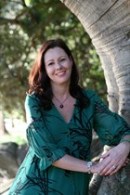I am honoured to welcome Kate Forsyth to Book’d Out today to celebrate the release of her latest book, The Beast’s Garden.
Kate Forsyth is the internationally bestselling author of more than thirty books, including The Witches of Eileanan and Rhiannon’s Ride fantasy series for adults. She completed a doctorate in fairytale retellings and the novels that have come out of this fascination include the winner of the 2015 American Libraries Association Prize for Historical Fiction, Bitter Greens, and The Wild Girl .
Filled with danger, intrigue and romance, The Beast’s Garden, a retelling of the Grimm brothers’ ‘Beauty and The Beast’, is a beautiful, compelling love story set in a time when the world seemed on the brink of collapse.
“It’s August 1939 in Germany, and Ava’s world is in turmoil. To save her father, she must marry a young Nazi officer, Leo von Löwenstein, who works for Hitler’s spy chief in Berlin. However, she hates and fears the brutal Nazi regime, and finds herself compelled to stand against it.
Ava joins an underground resistance movement that seeks to help victims survive the horrors of the German war machine. But she must live a double life, hiding her true feelings from her husband, even as she falls in love with him.
My review of the The Beast’s Garden can be read HERE but first please take the time to read Kate’s guest post…
Fairytale Retellings
I have loved fairy tale retellings ever since I read Eleanor Farjeon’s enchanting ‘Cinderella’ novel, The Glass Slipper, in primary school. Back then, there were only a few fairy tale retellings around – Eleanor Farjeon’s The Silver Curlew and Nicholas Stuart Grey’s The Stone Cage and The Seventh Swan among them.
In my late teens I discovered Robin McKinley and Patricia McKillip, and then read Jane Yolen’s heartbreaking retelling of ‘Sleeping Beauty’ set in World War II. I also loved C.S. Lewis’s retelling of the Eros & Psyche myth, Till We Have Faces, told from the point of view of Psyche’s ugly sister.
I began to be fascinated by the idea of using old tales in new and unexpected ways – telling the story from the point of view of the villain, for example. Each new reimagining illuminated the tale in surprising ways.
Retelling old tales is not a new fad.
Fairy tales, myths and legends have never been static. For as long as they have been told – which could well be more than 300,000 years – tales have been shaped and changed and altered by whoever told the tale. As humans explored the world, making contact with other cultures and other storytelling traditions, their tales travelled too … and were adopted and transformed for their new audiences.
Writers such as the 16th century Neapolitan courtier, Giambattista Basile, took old tales from the oral tradition and spun new stories out of their threads. He was a soldier in the service of the Venetian Republic, the heart of the Renaissance trade routes, and so is likely to have heard stories from many different cultures.
The French fairy tale writers in the 17th century did the same. They invented their fabulous tales … but were inspired by older tales that they had heard or read. Even the Grimm brothers – who began by wanting to record folktales as close to the oral tradition as possible – ended up rewriting them.
Hans Christian Anderson sometimes wrote new tales in the style of the old, and sometimes retold old tales in the style of the new. Oscar Wilde did the same.
Sometimes all that is left of the old oral tales are echoes – a god who must not be seen becomes a hideous beast, for example. A goddess who reawakens each spring becomes a sleeping princess.
So fairy tales have inspired and influenced writers as long as people have been taking up their quill to create. And they continue to retold, reimagined, subverted, and invented by writers to the present day.
Sometimes fairy tales are retold in such a way that their hidden messages about sexual desire are made explicit. Some turn the tales inside-out so their bloody lining is revealed.
Others prefer to modernise and sanitise the tales to make them more palatable to a modern-day audience (which is now commonly young children in a way that was not true in the early days of oral storytelling).
One famous Disney reversal of a fairy tale is its version of The Little Mermaid.
The original story – written by Hans Christian Andersen in 1836 – ends with the little mermaid flinging herself into the ocean after her prince marries another.
Disney’s 1989 version ends with the little mermaid turning into a human and marrying the man of her dreams.
Which is the right version, the true version?
The answer is … both of them and neither of them.
For fairy tales belong to all of humanity, and they survive – like a virus – by adapting to the culture that hosts it. A fairy tale that is not retold eventually dies, powerless and forgotten. A fairy tale that is retold, however, goes on living as long as someone continues to retell it.
The Beast’s Garden is available to purchase from
Random House I I Booktopia I Amazon AU I via Booko
I Booktopia I Amazon AU I via Booko
and all good bookstores.



One thought on “AWW Feature: Kate Forsyth, Fairytale Retellings and The Beast’s Garden”